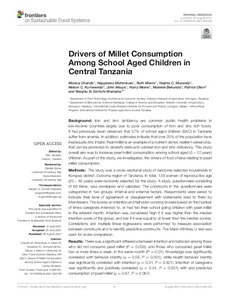| dc.contributor.author | Chande, M. |
| dc.contributor.author | Muhimbula, H. |
| dc.contributor.author | Mremi, R. |
| dc.contributor.author | Muzanila, Y.C. |
| dc.contributor.author | Kumwenda, N. |
| dc.contributor.author | Msuya, J. |
| dc.contributor.author | Msere, H. |
| dc.contributor.author | Bekunda, M. |
| dc.contributor.author | Okori, P. |
| dc.contributor.author | Gichohi-Wainaina, W.N. |
| dc.date.accessioned | 2021-08-25T10:05:03Z |
| dc.date.available | 2021-08-25T10:05:03Z |
| dc.date.issued | 2021 |
| dc.identifier.citation | Chande, M., Muhimbula, H., Mremi, R., Muzanila, Y., Kumwenda, N., Msuya, J., ... & Gichohi-Wainaina, W.N. (2021). Drivers of millet consumption among school aged children in central Tanzania. Frontiers in Sustainable Food Systems, 5, 694160: 1-13. |
| dc.identifier.issn | 2571-581X |
| dc.identifier.uri | https://hdl.handle.net/20.500.12478/7225 |
| dc.description.abstract | Background: Iron and zinc deficiency are common public health problems in low-income countries largely due to poor consumption of iron and zinc rich foods. It has previously been observed that 57% of school aged children (SAC) in Tanzania suffer from anemia. In addition, estimates indicate that over 25% of the population have inadequate zinc intake. Pearlmillet is an example of a nutrient dense, resilient cereal crop, that can be promoted to diversify diets and combat iron and zinc deficiency. This study overall aim was to increase pearl millet consumption among school aged (5 – 12 years) children. As part of the study, we investigated, the drivers of food choice relating to pearl millet consumption. Methods: The study was a cross-sectional study of randomly selected households in Kongwa district, Dodoma region of Tanzania. In total, 128 women of reproductive age (20 – 49 years) were randomly selected for the study. A study questionnaire consisting of 66 items, was developed and validated. The constructs in the questionnaire were categorized in two groups: internal and external factors. Respondents were asked to indicate their level of agreement or disagreement with statements read to them by interviewers. The scores on intention and behavior constructs were based on the number of times caregivers intended to, or had fed their school going children with pearl millet in the referent month. Intention was considered high if it was higher than the median intention score of the group, and low if it was equal to or lower than the median scores. Correlations and multiple linear regressions were performed to measure association between constructs and to identify predictive constructs. The Mann-Whitney U test was used for score comparison. Results: There was a significant difference between intention and behavior among those who did not consume pearl millet (P = 0.003), and those who consumed pearl millet two or more times a week, in the same month (P = 0.01). Knowledge was significantly correlated with behavior identity (r = 0.58, P = 0.001), while health behavior identity was significantly correlated with intention (r = 0.31, P = 0.001). Intention of caregivers was significantly and positively correlated (r = 0.44, P = 0.001) with and predicted consumption of pearl millet (r = 0.87, P = 0.067). Conclusion: Increasing knowledge or awareness on nutritional benefits of pearl millet among caregivers may increase consumption of pearl millet by children of school going age. |
| dc.description.sponsorship | United States Agency for International Development |
| dc.format.extent | 1-13 |
| dc.language.iso | en |
| dc.subject | Millets |
| dc.subject | Food |
| dc.subject | Children |
| dc.subject | Tanzania |
| dc.subject | Food Choice |
| dc.subject | Pearl Millet |
| dc.title | Drivers of millet consumption among school aged children in central Tanzania |
| dc.type | Journal Article |
| cg.contributor.crp | Maize |
| cg.contributor.affiliation | Sokoine University of Agriculture |
| cg.contributor.affiliation | International Crop Research Institute for the Semi-Arid Tropics |
| cg.contributor.affiliation | International Institute of Tropical Agriculture |
| cg.coverage.region | Africa |
| cg.coverage.region | East Africa |
| cg.coverage.country | Tanzania |
| cg.coverage.hub | Eastern Africa Hub |
| cg.researchtheme | Natural Resource Management |
| cg.identifier.bibtexciteid | CHANDE:2021 |
| cg.isijournal | ISI Journal |
| cg.authorship.types | CGIAR and developing country institute |
| cg.iitasubject | Agronomy |
| cg.iitasubject | Food Security |
| cg.iitasubject | Maize |
| cg.iitasubject | Plant Breeding |
| cg.iitasubject | Plant Production |
| cg.iitasubject | Value Chains |
| cg.journal | Frontiers in Sustainable Food Systems |
| cg.notes | Open Access Journal; Published online: 06 Aug 2021 |
| cg.accessibilitystatus | Open Access |
| cg.reviewstatus | Peer Review |
| cg.usagerightslicense | Creative Commons Attribution 4.0 (CC BY 0.0) |
| cg.targetaudience | Scientists |
| cg.identifier.doi | https://dx.doi.org/10.3389/fsufs.2021.694160 |
| cg.iitaauthor.identifier | Mateete Bekunda: 0000-0001-7297-9383 |
| cg.futureupdate.required | No |
| cg.identifier.issue | 694160 |
| cg.identifier.volume | 5 |

